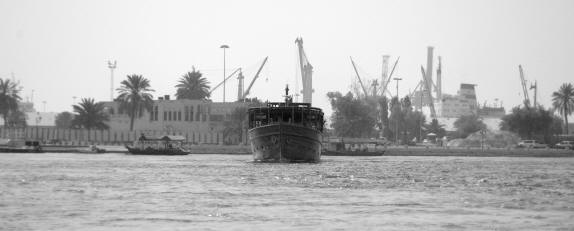|
AL SHINDAGAH
A Living History
Historically, old Dubai was divided into three main
areas: Shindagha, Bur Dubai, and Deira. Dubai Creek is the demarcation line
separating Bur Dubai from Deira. Shindagha, on the western bank of the Creek, is
separated from Deira by a sand stretch called Ghubaiba. It is located at the
southern end of the Creek overlooking its entrance which has historically been
the cityís maritime gate to the world.
The establishment of the area dates back to circa 1862. The area quickly
acquired a historical importance late 19th Century when the cityís population
started to increase significantly. At that time urban planning and constructing
new residential areas became a new necessity in the city. Moreover, Dubaiís
ruling family and most of Bani Yas tribe used to reside in Shindagha since H.H.
Sheikh Maktoum Bin Hashr relocated to live there at the end of the 19th Century.
The area attracted a huge degree of interest fro the public and the government
in the recent years which translated into many historical buildings renovation
projects. Works of repair and rehabilitation of the areaís historical buildings
consist of many phases. The number of the buildings in the area amounted 226 at
the rate of 62 usages such as residences, shops, souqs, etc.
The Municipalityís master plan to renovate the area started in 1996 and included
reviving the coastline path containing a set of buildings that have historical
value. Work also included rehabilitating these buildings for contemporary
functions among which the house of Sheikh Saeed Al-Maktoum, the two villages of
Al-Ghous and Turath (diving ans heritage), as well as the rehabilitation of the
historic originality of the house of Sheikh Obeid Bin Thani and a number of
traditional mosques.
The Second Phase, stated in 2005, included the implementation of repair projects
assumed by the Historical Buildings Department. Project covered in this phase
included the traditional market, rebuilding the house of H.H. Sheikh Hasher Al
Maktoum, and constructing heritage garden which accommodates a variety of
heritage activities and events as well as a traditional restaurant.
The house of H.H. Sheikh Saeed Al Maktoum, built in 1896 as a headquarters for
the Ruler, is one of the most historical buildings in the area. The building is
also important for the history of Dubai because of its artistic and
architectural aspect and its strategic location overlooking Dubaiís commercial
centre at the Creek.
When restoration works completed in 1986, the house of H.H. Sheikh Saeed Al
Maktoum was reintegrated with the modern life by using it as a museum for
historical images and documents of the emirate of Dubai. The museum was equipped
with modern and advanced display technologies to provide visitors with a rich
experience of Dubaiís history.
The building has been a popular tourism attraction contributing to the
development of Shindagha area in general. The sound restoration practices won
the project the Arab Cities Organization Award for Architectural Preservation.
Located to the south-east of old Shindagha area, the house of Sheikh Jum'a Bin
Maktoum Al Maktoum was also covered by restoration works. The building was
constructed in 1928 on a land measuring 1,085 square meters near Bin Zayed
Mosque.
Already restored also is the house of Sheikh Obaid Bin Thani at the centre part
of eastern Shindagha area to the north of the house of H. H. Sheikh Saeed Al
Maktom. The building was constructed in 1916 on a plot measuring 1250 square
meters.
Two diving & heritage villages have been built till now in old Shindagha to
provide the area with more entertainment and culture services and promote
overall tourism development. The diving & heritage village projects have revived
local architecture and introduced heritage as integral component of tourism
developments plans in Dubai and the UAE in general.
Restoration projects in Shindagha included seven historical mosques most of them
were constructed early 20th Century. Those are: Shiyookh Mosque, Otaibat Mosque,
Al Milla Mosque, Bin Zayed Mosque, Al Murr Bin Huraiz Mosque, Harib Bin Harib
Mosque.
In addition to Shindagha area, Dubai Municipalityís map of historical and
heritage sites in the emirate includes Grand Souq (Bur Dubai), Al Ras (Deira),
Grand Souq (Deira), Bastakiya, Hatta Heritage Village, and many other
architecture landmarks constructed by the Gulf inhabitants in old times.

|